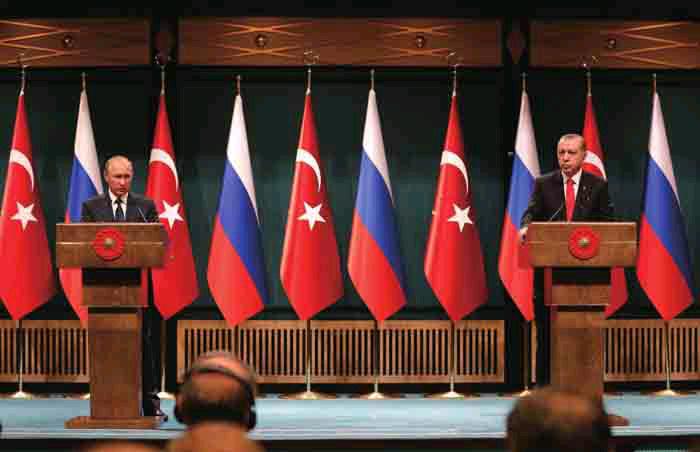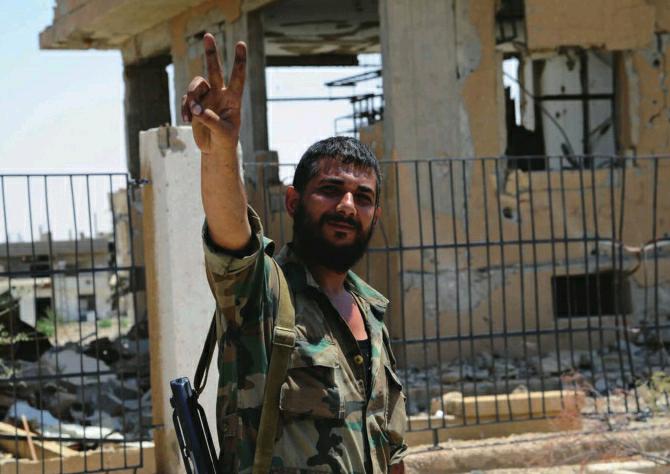A Sliver of Hope?
2017-11-06ByGongZheng
By+Gong+Zheng
Since March 2011, the prolonged war in Syria has become a nightmare haunting its people and delivering each of them the bitter taste of terror. As the Syrian conflict enters its seventh year, some positive changes have occurred. Will the Syrian people seize the sliver of hope for peace?
Favorable turn
“The liberation of Aleppo and Palmyra, the lifting of the siege of Deir al-Zour and the eradication of terrorism from many parts of Syria prove that victory is now within reach,” Syrian Foreign Minister Walid Muallem said on September 23 in his speech at the 72nd Session of the UN General Assembly in New York City.
Significant progress has been made in anti-terror efforts in Syria recently. The battle for the so-called Islamic State (IS) militant groups de facto capital in the country, Raqqa, has reached its fi nal stages after four months of fighting led by the U.S.-backed Syrian Democratic Force (SDF), a coalition of Kurdish and Arab militias. According to an SDF statement on September 20, 80 percent of the city had been liberated, and they would continue to clear mines and fi ght the remaining terrorists.
In east Syrias Deir al-Zour, government forces have broken the three-year siege by IS on government-held parts of the city and started an offensive to liberate the rest of the city, which is a great step toward the complete victory of removing IS forces from Syria.
As for the Syrian civil war, parties involved have mostly implemented a temporary ceasefi re in the de-escalation zones. During the peace talks on Syria in Kazakhstan capital Astana in May, Russia, Turkey and Iran agreed to set up three de-escalation zones in the opposition-controlled provinces of Latakia, Hama and Aleppo, with Russia, Turkey and Iran acting as guarantors, to decrease the intensity of conflict and alleviate the humanitarian crisis.
Since the establishment of the de-escalation zones, large-scale fighting between Syrian government forces and opposition militias has barely occurred, and they have even swapped besieged military personnel and their families.
On July 7, U.S. and Russia agreed to set up a new de-escalation zone in the southwestern part of Syria during a meeting between presidents Donald Trump and Vladimir Putin in Hamburg, Germany. Final agreement to create the fourth de-escalation zone in Idlib was reached in September.
Although de-escalation is far from peace, it has brought long-lost tranquility to the wartorn country.endprint
A U.S. turn-back
After Trump took office as U.S. president, Washington has speeded up the transformation of its policy toward Syria from that in place during Barack Obamas presidency and made some distinct shifts. In April, the United States launched the fi rst direct strike on a Syrian government airbase on Trumps command as not an escalation of the confl ict, but a limited punishment in response to an alleged chemical weapon attack, judging from later U.S. policy.
The Trump administrations policy in recent months has been characterized by increasing aid to the SDF and decreasing assistance to Syrian opposition forces. On the one hand, the United States has provided the SDF with more weapons to accelerate the fi ght against IS—supplying it in mid-September with military equipment worth $300 million, including mine-resistant armored vehicles and light weapons such as assault rifles, rocket launchers and mortars—with the aim of speeding up its liberation of IS-controlled areas.
On the other hand, a sharp drop was seen in U.S. aid to opposition forces. According to The Washington Post, one month before his meeting with Putin in Germany, Trump decided to end the covert program to aid and train moderate Syrian rebels to overthrow the Syrian Government led by President Bashar al-Assad after discussions with Central Intelligence Agency Director Mike Pompeo and National Security Advisor H.R. McMaster.
Unoptimistic prospect
Will victory against IS and the U.S. policy shift signify the easing of the Syrian crisis? Has the possibility of a political settlement of the crisis increased? It is still too early to make such judgments, as fresh problems will likely emerge.
Thats because interest divergence, strategic confrontation and opposed stances of involved parties would become more obvious once their common enemy—IS—was defeated. Recent signs have shown that a scramble for spheres of inf luence has begun, despite the anti-terrorist war being far from its end.
First, the areas controlled by IS enjoy significant geopolitical and strategic importance. Mainly scattered in the deserts, these areas include oases, crossings and ports on the 600-km border between Syria and Iraq and provide the only land routes connecting Syria, Iraq and Iran. Deir al-Zour, in particular, is of vital strategic importance to Syria.
More importantly, two thirds of Syrias oil reserves and almost all of its onshore natural gas resources are mainly located in IS-held desert areas in its eastern part, which will provide huge fi nancial support for the countrys post-war reconstruction. Meanwhile, by securing its control of the areas, the Syrian Government could benefit from future oil and gas pipelines routed from Iraq through Syria to Mediterranean Sea ports.endprint
On September 18, the Russian Defense Ministry declared that Syrian government forces had crossed the Euphrates river. The United States, however, responded that the move was a break of the deconfl iction line, which observers said would increase the likelihood of confrontation between U.S. and Russian proxies. It was said that Syrian government forces were less than 5 km from the U.S.-backed SDF.
Moreover, the involvement of U.S. and Russian military personnel in rival Syrian forces will increase the risk of indirect conflict. On September 21, Russia warned the United States of the danger of direct conflicts and threatened to retaliate U.S.-backed ground troops if Syrian government forces were attacked.
The scramble in east Syria creates new uncertainty for the volatile U.S.-Russia ties. A proxy war in Syria is highly likely if both Russia and the United States pay insuffi cient attention to, or deliberately ignore, crisis control and management, which is bad news for the already tattered Middle East.endprint
